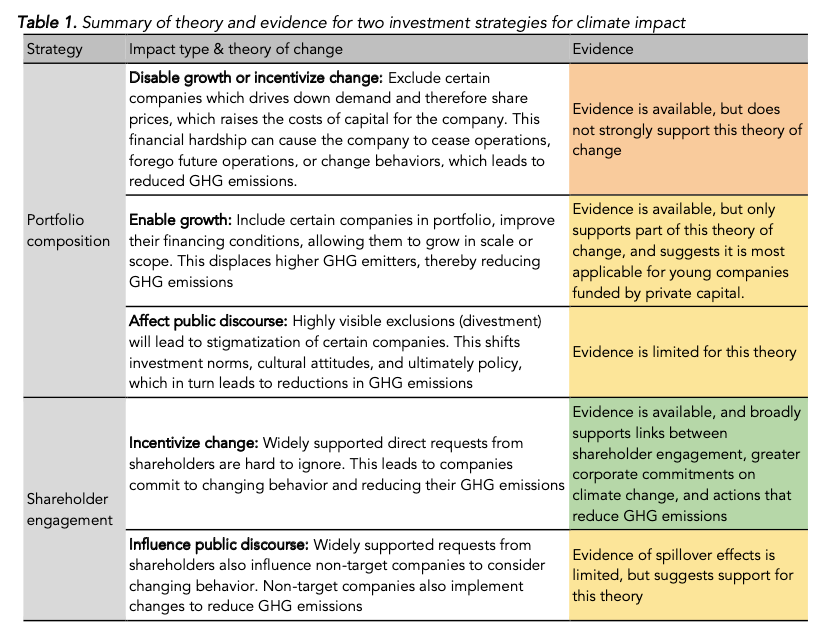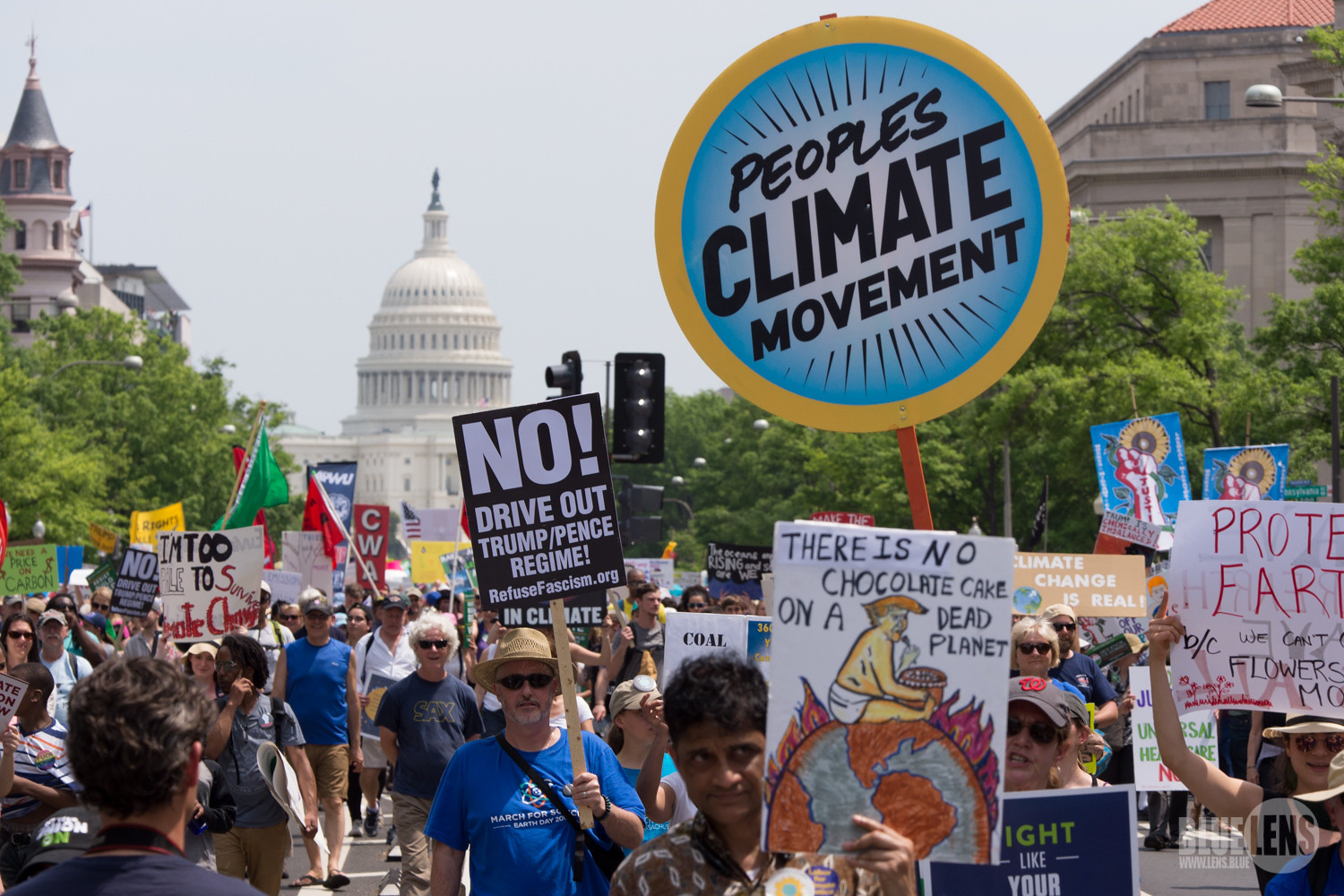ESG Funds & Climate Impact: Strategy Report
This report was last updated in November 2021. It may no longer be accurate, both with respect to the evidence it presents and our assessment of the evidence. We may revise this report in the future, depending on our research capacity and research priorities. Questions and comments are welcome.
Note: This article is intended for research and information purposes only in order to review the potential positive climate impacts of available investment opportunities, not their financial performance, and therefore should not be construed as investment, financial, or other advice, or construed as a recommendation to buy, sell, or otherwise transact in any investment. We do not endorse any specific product that is referenced in this article. This article is not a replacement for personal financial advice and it is strongly recommended that you review your own personal financial situation and seek professional investment and/or financial advice before engaging in any investing. Reading this article does not create a professional relationship and we are not in the business of providing investment or financial advice. The information provided in this article is as accurate as possible, however errors may occasionally occur and we are not responsible for any errors. We expressly disclaim any liability or loss incurred by any person who acts on the information, ideas, or strategies discussed in this report.
Executive Summary
Is it possible to save for retirement, a home purchase, or college tuition while also pushing corporations to act on climate change? We think it might be. In this overview, we explore the ways Environmental, Social, and Governance (ESG) investing in mutual funds and exchange-traded funds might move the needle on corporate climate action and reduce GHG emissions.

Because ESG includes “environment” as one of its pillars, it is often the starting point for retail investors hoping to use their money to have an impact on climate change. But we find that ESG funds are often not designed to have an impact on any environmental, social or governance outcomes at all. The rise of these sustainable investment funds has been driven by three types of investor motivation: values alignment, financial performance and (less frequently) impact. Additionally, we find ESG scores for specific companies to be an unreliable shorthand for climate performance. This is because ESG scores for companies rely on voluntary disclosures, often contradict each other, and aggregate climate metrics with many other metrics. This allows companies to obscure their climate record with better performance on other metrics. We find ESG, in general, to be an unreliable shorthand for climate-forward investments.
There are some ESG funds that do claim to have an impact on the climate. Although investment managers use an array of terms to describe how their climate-focused funds deviate from conventional funds, we suggest it boils down to two main approaches: portfolio composition, or “what the fund holds”; and shareholder activism, or “what the fund does.” Climate funds vary in the type of information they use to build their portfolio (e.g., ESG scores, sector or industry, specific practices) and the way they use that information (e.g., screening or weighting certain companies in their portfolio). The most common strategy portfolio composition strategy used by climate funds is fossil fuel divestment. Climate funds also vary in the degree of shareholder activism they engage in. These funds can pressure companies to change behavior by introducing shareholder resolutions, voting on proxy ballots, and other informal strategies. Many climate funds combine some type of portfolio composition approach with shareholder action.
But how likely is it for these two main strategies to lead to climate impacts? For that, we explore the theories of change and available empirical evidence, summarized in Table 1 below.

We find that the evidence on the impact of fossil fuel divestment is mixed. Based on our current research, we see the most potential for near-term impact on climate from funds that concentrate on shareholder engagement, either on its own or in coordination with divestment strategies. As such, we recommend climate-focused retail investors pay attention to a fund’s track record of shareholder engagement, rather than just its portfolio composition strategy.
We close by describing three main categories of funds that are using shareholder activism to push for climate action. We did not consider the financial viability of these funds, beyond a basic observation of the fund fees, and the examples we provide do not constitute investment advice.
- Smaller, newer funds which appear to have transparent, sophisticated climate investment strategies and a stated intention to leverage shareholder engagement to induce climate action but are too new to have any track record of success (e.g., Engine No. 1’s ETF, Carbon Collective, and others). These funds also claim to offer fees that are comparable to conventional funds.
- Older, medium-sized funds with proven track records of pushing companies to reduce GHG emissions through shareholder engagement (e.g., Green Century Funds, Trillium Asset Managers, Zevin Asset Management, and others). These types of funds often charge fees that are somewhat higher than fees charged by non-sustainable actively managed funds.
- Larger, often generic funds which have greater influence over proxy votes due to the size of their holdings and tend to outperform their peers in their support for climate resolution (e.g., Hartford Funds or Columbia Threadneedle). We also note that the two largest asset managers in the United States, Blackrock, and Vanguard, had some of the lowest rates of support for climate resolutions in 2020.
Investing for the climate is challenging. Individual retail investor choices are necessarily an indirect path to impact but investing in funds that use their influence as shareholders to drive climate action appears to be a promising strategy. Good signs include funds actively engaging their portfolio companies on climate issues, funds introducing and voting in favor of climate-forward resolutions, and funds that have sophisticated, climate-specific, transparent criteria for inclusion.
Download the full report above for more about ESG, the academic literature on its impact (or not), and our conclusions on climate impact.
Support Our Work
Giving Green Fund
One fund. Global impact. One hundred percent of your gift supports a portfolio of high-impact climate organizations, vetted by our research.
Best for:
Donors who want the simplest way to impact multiple climate solutions.
Top Climate Nonprofits
Meet the organizations on Giving Green’s list of high-impact nonprofits working to decarbonize our future, identified through our rigorous research.
Best for:
Donors who want to give directly and independently.
Support Our Work
We thoroughly research climate initiatives so you can give with confidence. For every $1 we receive, our work unlocks another $21 for effective climate solutions.
Best for:
Donors who want to amplify their impact through research.
.png)

.png)
.png)

.png)


.png)
.png)
.png)



.png)



.png)
.png)
.png)
.png)
.png)






.png)









.png)
.jpg)
.png)


.png)

.jpg)
.png)



.png)

.png)
.png)
.png)



.png)


.png)
.png)

.png)

.png)
.png)


.png)









.png)

.png)
.png)
.png)


.png)
